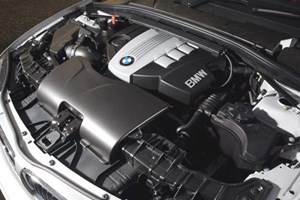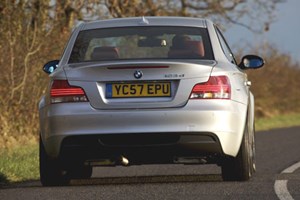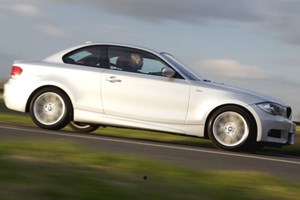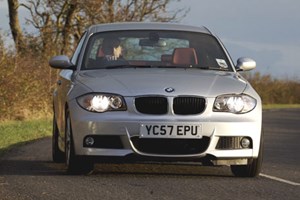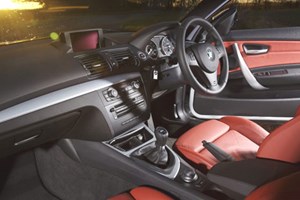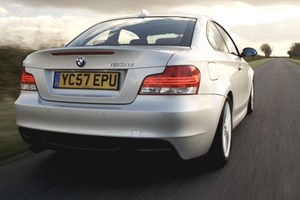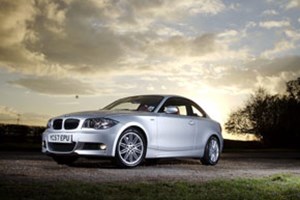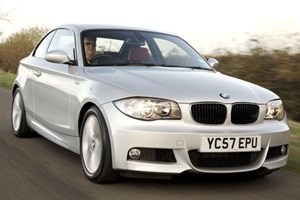
BMW 123d Coupe M Sport
| How much? | £26,290 |
|---|---|
| On sale in the UK: | Now |
| Engine: | 1995cc 4-cyl twin-turbo diesel, 204bhp @ 4400rpm, 295lb ft @ 2000rpm |
| Transmission: | Six-speed manual, rear wheel drive |
| Performance: | 7.0 sec 0-60mph, 142mpg, 54.3mpg, 128g/km CO2 |
| How heavy / made of? | 1495kg/steel |
| How big (length/width/height in mm)? | 4360/1748/1408 |
You quite liked the 135i Coupe, didn’t you. But aren’t the bulk of sales going to be diesel?
You’re right – and until the 125i arrives next year, diesel is the dominant engine in the 1-Series Coupe range. How times change. The 120d boasts 177bhp (to think we thought a 1990s 325i, with 170bhp, was fast) but it’s the range-topper that’s the most interesting.
The 123d, benefiting from BMW’s sequential twin turbo technology already seen on the 535d, boosts this 2.0-litre four to 204bhp. That’s right – 100bhp per litre. That's a pretty exceptional achievement for petrol engines - but for a diesel to crack it is, well, quite something else.
That is quite amazing...
And there’s more. It has 295lb ft of torque at just 2000rpm - which matches the twin-turbo 135i - but unlike the petrol flagship which likes a bit of a drink, the 123d returns 54.3mpg on the combined cycle. Yes, 54.3mpg. And it emits just 138g/km of CO2. And will still shoot to 62mph in 7.0 seconds and push on to 148mph.
That's a simply remarkable set of stats to sit in the same paragraph as each other. Apparently, BMW’s engineers celebrated by turning the water they were drinking into wine. Lafite Rothschild 1947, no less.
But I've driven hot diesels before and they're either on or off. Fun at first bust then very frustrating...
That's the beauty of the twin-turbo technology. As you know, a small turbine handles the low-rev stuff for instant low-speed pick-up, while a larger blower takes over as the revs rise for top end punch.
This has two effects – one, throttle response is almost immediate, certainly not much tardier than the blown petrol. And two, it’s beautifully linear and controllable. Which means you can either enjoy rocket-like acceleration or gather speed in a more genteel fashion depending on how you treat the incredible precise throttle.
OK, so it’s nice to operate. But what’s it like to use everyday?
This is BMW’s latest-generation 2.0-litre diesel, which is significantly quieter and less clattery than its predecessor. Balancer shafts add smoothness, too. In practice, it’s surprisingly free-revving, makes a not completely unappealing noise and revs to its 5000rpm soft limiter with surprising keeness.
Plentiful torque at low revs and appreciable power over 3000rpm means gears are not essential and this powertrain proves that diesels can be genuinely athletic and engaging, with a throttle response devoid of that on-throttle pause many diesels suffer. The M Sport’s ride is on the firm side of firm, but the latest generation of runflat tyres mean it’s not sickeningly harsh and crashy anymore.
Doesn't a great big diesel engie over the nose sabotage the handling?
No, in a word. The 123d's diesel engine is lighter than the 135i's biturbo unit, and overall, the diesel car is lighter than the petrol (1495kg versus 1560kg) so the coupe's superb chassis balance is unaffacted. From behind its thick-rimmed steering wheel it feels remarkably similiar to the 135i.
The M Sport model we drove had the same precise but anaesthetised steering as the 135i, and the same propensity towards understeer when pushing hard. But turn off the traction control and all that torque can easily unsettle the chunky 245/35profile 18-inch rear tyres, allowing you to drive the Beemer on the throttle - or easily boot out the tail end for smoke sideways action if that's your thing...
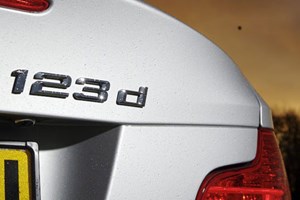
Still not sure about that shape, though...
Well, it is interesting, true. On the road, it’s much less three-box saloon than it appears in images, and the bulge of the rear wheels is quite amusing – as is the way those front wheels look like they’re straining to overtake the rest of the car. The 1-Series makes much of playing with light, too. It’s a complex design that takes time to ‘read’, but it’s certainly growing on us.
Inside, the two-seat rear is tight, of course, but the shallow boot is actually 20 litres bigger than the hatch. We also like the low-slung seats and driver-centric cabin, even if some of the plastics are far too cheap in a car costing this much.
I keep coming back to that economy. How have they achieved it?
Well, hyper-advanced engine technology aside, don't forget that the 1-series coupe comes with BMW's hyped Efficient Dynamics set-up. Start-Stop is the most obvious of these, and it’s although it's initially amusing to have a performance car that turns itself off at the traffic lights, it soon becomes second nature.
Even more pleasing is how this rival-less coupe costs £24,855 (or £26,290 in M Sport form), which is a good chunk less than the 135i. When you consider that even a base-spec 320d SE Coupe costs over £28k, the 123d looks like a relative performance bargain.
Verdict
The 123d Coupe is a hugely compelling car. Sure, its compromised packaging, cost and like-it-hate-it looks will put off a number of potential buyers but we loved its peerless combination of performance, economy, dynamic engagement and refinment. It also brings together scalpel sharp technology in a very accessible and user-friendly package, with consumption and emission figures strong enough to tackle most hybrids. Its our 1-series of choice.
CAR's rating
Handling
Performance
Usability
Feelgood factor
Readers' rating
